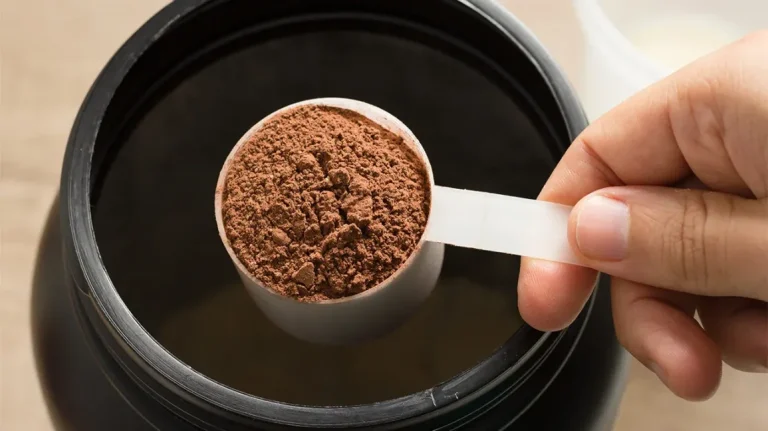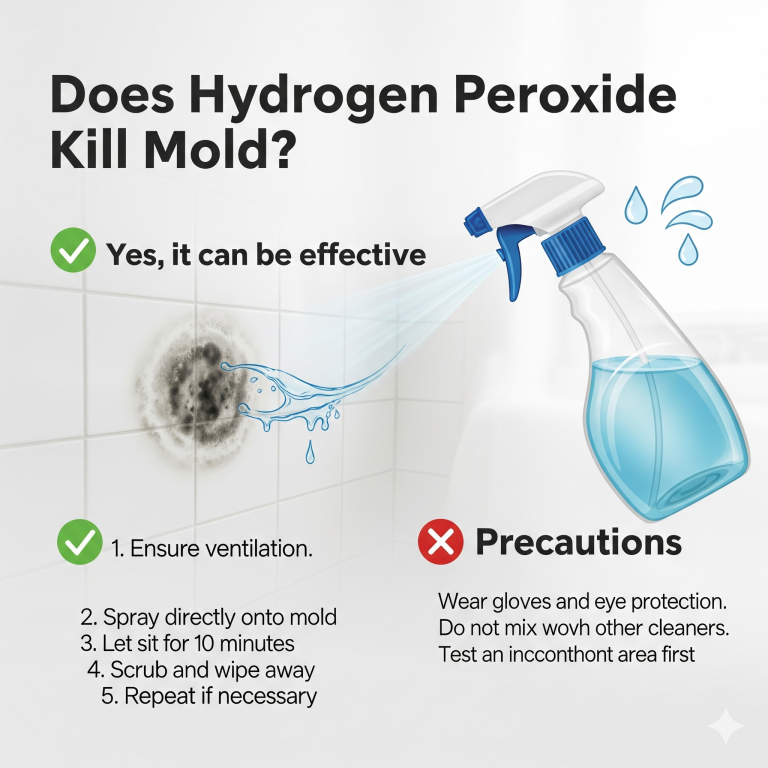
Does Hydrogen Peroxide Kill Mold?
Table of Contents
Mold is a public domestic nuisance that can wreak havoc on both your health and your home’s construction. While some mold types are relatively harmless, others can cause thoughtful health issues like sensible problems, skin frustration, and other sensitive responses. In the battle against mold, many people seek real and safe housework answers to remove it from some shells. One such result that has stored attention is hydrogen peroxide.
You may wonder: does hydrogen peroxide kill mold? This article explores the science behind hydrogen peroxide’s mold-fighting assets, comparations changed people, and offers practical advice on its application for mold removal. We’ll take a closer look at how active hydrogen peroxide is in removing mold at many assets.
The Science of Hydrogen Peroxide and Mold
Hydrogen peroxide (H₂O₂) is a chemical complex containing of two hydrogen atoms and two oxygen atoms. In its normal form, hydrogen peroxide is a colorless liquid with a slightly higher viscosity than water. It is most commonly found in concentrations ranging from 3% to 12% for family and manufacturing use, though stronger attentions like 14% are also available for more heavy-duty tasks.
But does hydrogen peroxide kill mold? The answerDoes Hydrogen Peroxide Kill Mold?Amazing Exploring the Effectiveness of 14% and 5.4% Concentrations lies in hydrogen peroxide’s oxidizing nature. When applied to mold, hydrogen peroxide breaks down into water and oxygen, releasing free radicals that damage the mold’s cellular structure. This oxidation procedure disrupts the mold’s growth and can successfully kill the spores. Whether you’re dealing with small patches of mold or more dogged attacks, hydrogen peroxide can be an actual solution.
Hydrogen Peroxide Concentrations: 14% vs. 5.4%
Hydrogen peroxide is available in flexible attentions, Does Hydrogen Peroxide Kill Moldand the success of theDoes Hydrogen Peroxide Kill Mold complex can depend deeply on the attention used. Typically, 3% hydrogen peroxide is found in most household crops, while higher attentions like 5.4% and 14% are used for more industrial claims. Let’s break down how each attention comparisons when replying the question: Does hydrogen peroxide kill mold?
1. 5.4% Hydrogen Peroxide: A Mild Selection
A attention of 5.4% hydrogen peroxide is a sensible level that is still safe for many general uses but more strong than the normal 3% solution. For mold removal, this attention is actual on minor mold attacks, specially when the mold is still in its early stages.
So, does hydrogen peroxide kill mold at 5.4%? Yes, it does. The 5.4% solution can effectively kill mold on surfaces like walls, highest, and bathroom tiles. However, its power may not be enough for more genral mold groups.
2. 14% Hydrogen Peroxide: A More Powerful Solution
For better or more firm mold problems, a 14% hydrogen peroxide attention is often the go-to choice. This higher concentration is much more potent and can be especially effective on stubborn or deeply rooted mold colonies. When asking, does hydrogen peroxide kill mold in tougher conditions, the answer is a resounding yes with the 14% solution. The higher attention can break down mold faster and penetrate deeper into porous materials like wood and drywall.
How to Use Hydrogen Peroxide for Fungus Removal
No matter the attention, hydrogen peroxide can be a highly actual tool for mold barring when used properly. Here’s a step-by-step guide to help you answer the question, does hydrogen peroxide kill mold in your home.
What You’ll Need:
- Hydrogen peroxide (5.4% or 14%)
- Spray bottle (if not already in one)
- Defensive gloves
- Defensive eyewear
- Scrub brush or sponge
- Old towels or rags
- A bucket of water for rinsing
- A fan for ventilation
- Does Hydrogen Peroxide Kill Mould
Steps for Application:
- Prepare the Area:
Confirm that the area where you plan to remove mold is well-ventilated. Mold spores can become airborne during housework, so it’s vital to have good airflow to decrease contact. You may also want to use an air cleanser. This is mostly important when applying hydrogen peroxide, as you’re dealing with a sensitive matter. - Apply Hydrogen Peroxide:
Pour your hydrogen peroxide solution into a spray bottle. Apply it kindly to the moldy surface. Wait for at least 10-15 minutes. During this time, the hydrogen peroxide will break down the mold. So, does hydrogen peroxide kill mold during this waiting period? Unconditionally! The oxidation procedure begins as soon as the solution contacts the spores, weakening their structure and leading to their death. - Scrub the Surface:
After allowing the hydrogen peroxide to sit, use a scrub brush or sponge to remove the untied mold. The hydrogen peroxide solution makes it cooler to scrub off stubborn covers, helping to answer does hydrogen peroxide kill mold by physically removing it from surfaces. - Wipe Away Residue:
After cleaning, use a clean towel or rag to wipe away any mold debris and remaining hydrogen peroxide. If needed, rinse the area with water to clear away any residual solution. - Dry the Area:
To prevent new mold from growing, make sure to thoroughly dry the cleaned area. Mold thrives in moist atmospheres, so drying it out is thoughtful. Fans or dehumidifiers can be useful in this step.
Safety Considerations When Using Hydrogen Peroxide
While hydrogen peroxide is effective in killing mold, it’s important to take proper safety protections. Here are some things to keep in mind:
- Protective Gear:
Always wear gloves and protecting eyewear when using hydrogen peroxide, mainly in higher attentions like 14%. This ensures that your skin and eyes remain safe from any irritation. For those asking does hydrogen peroxide kill mold, safety should be your importance to avoid any harmful side effects. - Ventilation:
Confirm that the area is well-ventilated. High attentions of hydrogen peroxide issue oxygen and can create vapors that are exasperating to the respiratory system. Opening windows or using an air cleanser can help answer the question, does hydrogen peroxidekill mold without flexible your air value. - Surface
Test hydrogen peroxide on a minor, unseen area of the external before using it widely. Hydrogen peroxide can bleach some materials, so it’s critical to make sure the solution doesn’t damage the surface. Always check if does hydrogen peroxide kill mold on the exact material you’re working with.
Conclusion
So, does hydrogen peroxide kill mold? The answer is yes. Hydrogen peroxide, specially in strengths like 5.4% and 14%, is a commanding and actual way to remove mold. Its oxidizing properties break down mold spores and stop their growth, making it a safer another to harsh chemical cleaners. Whether you’re dealing with small spots of mold or larger invasions, hydrogen peroxide can help you restore a clean, mold-free environment

Always remember to take proper safety defenses and follow the correct procedure when using hydrogen peroxide for mold removal. By doing so, you can confidently say that hydrogen peroxide kills mold and keep your home clean and healthy.
FAQS
Q1: Does Hydrogen Peroxide Kill Mold?
Yes. Hydrogen peroxide effectively kills mold by breaking down its cell walls and disinfecting affected surfaces.
Q2: What is the best concentration of hydrogen peroxide for mold removal?
✅ A 3% solution works for light cleaning. Stronger infestations respond better to 5.4%–14% hydrogen peroxide.
Q3: How do I use hydrogen peroxide to kill mold?
✅ Spray it directly on the moldy surface, leave for 10–15 minutes, then scrub and rinse. Always wear gloves and ensure good ventilation.
Q4: Is hydrogen peroxide safer than bleach for mold removal?
✅ Yes. It does not produce toxic fumes and penetrates surfaces better, making it a safer alternative to bleach.
Q5: Does hydrogen peroxide prevent mold from returning?
✅ It kills existing mold but is not a permanent barrier. Keeping areas dry and well-ventilated helps prevent regrowth.
Q6: Can hydrogen peroxide be mixed with other cleaners for mold removal?
✅ No. Never mix hydrogen peroxide with bleach or vinegar; it can create dangerous chemical reactions. Use it alone for safety
You can also read
Is Hot Sauce Good for You? Shocking Health Benefits



